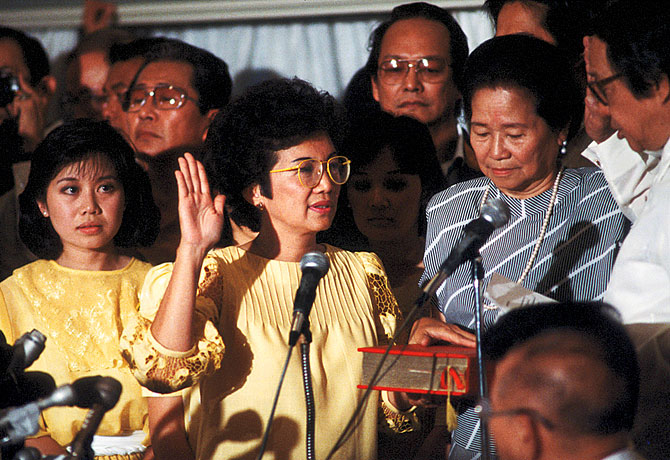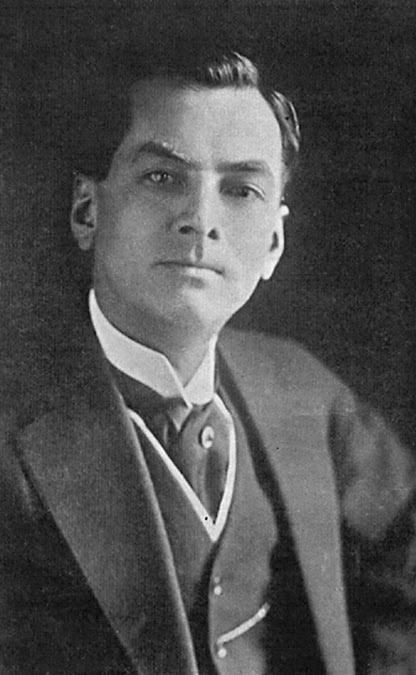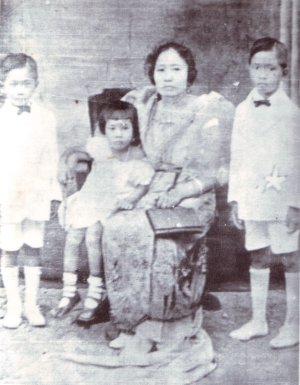|
Quezon Avenue
Manuel L. Quezon Avenue, more often called as Quezon Avenue, or simply Quezon Ave (pronounced: ''Ke-zon-Av''), is a major thoroughfare in Metro Manila named after President Manuel Luis Quezon, the second president of the Philippines. The avenue starts at the Quezon Memorial Circle and runs through to the Mabuhay Rotonda near the boundary of Quezon City and Manila. Lined with palm trees on its center island and spanning six to fourteen lanes, it is a major north-south and east-west corridor of Quezon City. Many government and commercial buildings line the road. At its north end, the Triangle Park, one of Quezon City's Central Business District, is the third most important industrial center in the city. At its south end, it connects Quezon City to the Philippine's capital – Manila connecting with Eulogio Rodriguez Sr. Avenue. It is a regular route for vehicles from Quezon City leading to Manila, as the highway provide access to Quiapo and the University Belt. History The ... [...More Info...] [...Related Items...] OR: [Wikipedia] [Google] [Baidu] |
Radial Road 7
Radial Road 7 is a network of roads in Metro Manila, connecting the cities of Manila, Quezon City and Caloocan, as well as San Jose del Monte and the municipality of Norzagaray in the province of Bulacan. The road is one of 10 radial roads in Metro Manila that connect the City of Manila with various provinces. Route description Lerma Street Lerma Street is an 8-lane road connecting Quezon Boulevard ( R-8) and España Boulevard in Sampaloc, Manila. España Boulevard España Boulevard is an 8-lane road starting from the junction of Lerma Avenue and Nicanor Reyes Street, ending in the Mabuhay Rotonda (otherwise known as Welcome Rotonda) in Quezon City. It passes through the northernmost areas of the University Belt, including the University of Santo Tomas and Ramon Magsaysay High School. Past RMHS, it passes through the mostly residential and commercial area of Sampaloc. Quezon Avenue Quezon Avenue starts from the Mabuhay Rotunda and ends in the Elliptical Road. It is one o ... [...More Info...] [...Related Items...] OR: [Wikipedia] [Google] [Baidu] |
Quezon City
Quezon City (, ; fil, Lungsod Quezon ), also known as the City of Quezon and Q.C. (read in Filipino as Kyusi), is the List of cities in the Philippines, most populous city in the Philippines. According to the 2020 census, it has a population of 2,960,048 people. It was founded on October 12, 1939, and was named after Manuel L. Quezon, the List of presidents of the Philippines, second president of the Philippines. The city was intended to be the Capital of the Philippines, national capital of the Philippines that would replace Manila, as the latter was suffering from overcrowding, lack of housing, poor sanitation, and traffic congestion. To create Quezon City, several barrios were carved out from the towns of Caloocan, Marikina, San Juan, Metro Manila, San Juan and Pasig, in addition to the eight vast estates the Philippine government purchased for this purpose. It was officially proclaimed as the national capital on October 12, 1949, and several government departments and i ... [...More Info...] [...Related Items...] OR: [Wikipedia] [Google] [Baidu] |
N170 (Philippines)
The N170 is a component of the event-related potential (ERP) that reflects the neural processing of faces, familiar objects or words. Furthermore, the N170 is modulated by prediction error processes. When potentials evoked by images of faces are compared to those elicited by other visual stimuli, the former show increased negativity 130-200 ms after stimulus presentation. This response is maximal over occipito-temporal electrode sites, which is consistent with a source located at the fusiform and inferior-temporal gyri, confirmed by electrocorticography. The N170 generally displays right-hemisphere lateralization and has been linked with the structural encoding of faces, hence is considered to be primarily sensitive to faces. A study, employing transcranial magnetic stimulation combined with EEG, found that N170 can be modulated by top-down influences from prefrontal cortex. History The N170 was first described by Shlomo Bentin and colleagues in 1996, who measured ERPs from par ... [...More Info...] [...Related Items...] OR: [Wikipedia] [Google] [Baidu] |
Central Business District
A central business district (CBD) is the commercial and business centre of a city. It contains commercial space and offices, and in larger cities will often be described as a financial district. Geographically, it often coincides with the "city centre" or "downtown". However, these concepts are not necessarily synonymous: many cities have a central ''business'' district located away from its commercial and or cultural centre and or downtown/city centre, and there may be multiple CBDs within a single urban area. The CBD will often be characterised by a high degree of accessibility as well as a large variety and concentration of specialised goods and services compared to other parts of the city. For instance, Midtown Manhattan, New York City, is the largest central business district in the city and in the United States. London's city centre is usually regarded as encompassing the historic City of London and the medieval City of Westminster, while the City of London and the transform ... [...More Info...] [...Related Items...] OR: [Wikipedia] [Google] [Baidu] |
Constitution Of The Philippines
The Constitution of the Philippines (Filipino: ''Saligang Batas ng Pilipinas'' or ''Konstitusyon ng Pilipinas'', Spanish: ''Constitución de la República de Filipinas'') is the constitution or the supreme law of the Republic of the Philippines. Its final draft was completed by the Constitutional Commission on October 12, 1986, and ratified by a nationwide plebiscite on February 2, 1987. Three other constitutions have effectively governed the country in its history: the 1935 Commonwealth Constitution, the 1973 Constitution, and the 1986 Freedom Constitution. The earliest constitution establishing a "Philippine Republic", the 1899 Malolos Constitution, was never fully implemented throughout the Philippines and did not establish a state that was internationally recognized, due in great part to the eruption of the Philippine–American War. Background of the 1987 Constitution Ruling by decree during the early months of her tenure as a president installed via the People Power ... [...More Info...] [...Related Items...] OR: [Wikipedia] [Google] [Baidu] |
Corazon Aquino
Maria Corazon "Cory" Sumulong Cojuangco-Aquino (; ; January 25, 1933 – August 1, 2009) was a Filipina politician who served as the 11th president of the Philippines from 1986 to 1992. She was the most prominent figure of the 1986 People Power Revolution, which ended the two-decade rule of President Ferdinand Marcos and led to the establishment of the current democratic Fifth Philippine Republic. Corazon Aquino was married to Senator Benigno Aquino Jr., who was one of the most prominent critics of President Marcos. After the assassination of her husband on August 21, 1983, she emerged as leader of the opposition against the president. In late 1985, Marcos called for a snap election, and Aquino ran for president with former Senator Salvador Laurel as her running mate for vice president. After the election held on February 7, 1986, the Batasang Pambansa proclaimed Marcos and his running mate Arturo Tolentino as the winners, which prompted allegations of electoral fraud ... [...More Info...] [...Related Items...] OR: [Wikipedia] [Google] [Baidu] |
People Power Revolution
The People Power Revolution, also known as the EDSA Revolution or the February Revolution, was a series of popular Demonstration (people), demonstrations in the Philippines, mostly in Metro Manila, from February 22 to 25, 1986. There was a sustained campaign of civil resistance against regime violence and electoral fraud. The nonviolent revolution led to the departure of Ferdinand Marcos, the end of his 20-year dictatorship and the restoration of democracy in the Philippines. It is also referred to as the Yellow Revolution due to the presence of yellow ribbons during demonstrations (in reference to the Tony Orlando and Dawn song "Tie a Yellow Ribbon Round the Ole Oak Tree") as a symbol of protest following the Assassination of Benigno Aquino Jr., assassination of Filipino senator Benigno "Ninoy" Aquino, Jr. in August 1983 upon his return to the Philippines from exile. It was widely seen as a victory of the people against two decades of presidential rule by President Marcos, ... [...More Info...] [...Related Items...] OR: [Wikipedia] [Google] [Baidu] |
Manuel Quezon
Manuel Luis Quezon y Molina, (; 19 August 1878 – 1 August 1944), also known by his initials MLQ, was a Filipino lawyer, statesman, soldier and politician who served as president of the Commonwealth of the Philippines from 1935 until his death in 1944. He was the first Filipino to head a government of the entire Philippines (as opposed to the government of previous Philippine states), and is considered to have been the second president of the Philippines, after Emilio Aguinaldo (1899–1901), whom Quezon defeated in the 1935 presidential election. During his presidency, Quezon tackled the problem of landless peasants in the countryside. His other major decisions include the reorganization of the islands' military defense, approval of a recommendation for government reorganization, the promotion of settlement and development in Mindanao, dealing with the foreign stranglehold on Philippine trade and commerce, proposals for land reform, and opposing graft and corruption within ... [...More Info...] [...Related Items...] OR: [Wikipedia] [Google] [Baidu] |
Ferdinand Marcos
Ferdinand Emmanuel Edralin Marcos Sr. ( , , ; September 11, 1917 – September 28, 1989) was a Filipino politician, lawyer, dictator, and kleptocrat who was the 10th president of the Philippines from 1965 to 1986. He ruled under martial law from 1972 until 1981 p. 189. and kept most of his martial law powers until he was deposed in 1986, branding his rule as "constitutional authoritarianism" under his Kilusang Bagong Lipunan (New Society Movement). One of the most controversial leaders of the 20th century, Marcos's rule was infamous for its corruption, extravagance, and brutality. Marcos gained political success by claiming to have been the "most decorated war hero in the Philippines", but many of his claims have been found to be false, with United States Army documents describing his wartime claims as "fraudulent" and "absurd". After World War II, he became a lawyer then served in the Philippine House of Representatives from 1949 to 1959 and the Philippine Senate from ... [...More Info...] [...Related Items...] OR: [Wikipedia] [Google] [Baidu] |
Mariano Marcos
Mariano Marcos y Rubio (; April 21, 1897 – March 8, 1945) was a lawyer, educator, and politician from Batac, Ilocos Norte, Philippines. A Congressman from 1925 to 1931, he is best known for being the father of Ferdinand Marcos, who was President of the Philippines from 1965 to 1986, and the grandfather of current Philippine president Bongbong Marcos. There are conflicting accounts about the exact nature of his death, with the mainstream version coming from American guerilla unit leader Major Robert Lapham saying that he was drawn and quartered in Bacnotan, La Union by Lapham's guerilla unit for being a Japanese collaborator, while the version of the Marcos Family suggested he was executed by the Japanese. He is the namesake of two Philippine state universities: the Mariano Marcos State University in Ilocos Norte, and the Don Mariano Marcos Memorial State University in La Union, as well as the town of Marcos, Ilocos Norte. Early life Mariano Marcos was born in Batac, Ilocos N ... [...More Info...] [...Related Items...] OR: [Wikipedia] [Google] [Baidu] |
Commonwealth Avenue, Quezon City
Commonwealth Avenue, formerly known as Don Mariano Marcos Avenue, is a highway located in Quezon City, Philippines, which spans from six to eighteen lanes and is the widest in the Philippines. It is one of the major roads in Metro Manila and is designated as part of Radial Road 7 (R-7) of the older Manila arterial road system and National Route 170 (N170) of the Philippine highway network. Commonwealth Avenue starts from Elliptical Road, which circumscribes the Quezon Memorial Circle, and it passes through the areas of Philcoa, Tandang Sora, Balara, Batasan Hills, Fairview, and ends at Quirino Highway in the Novaliches area. The avenue, being located on Quezon City, which is listed as one of several cities in Metro Manila with high incidence of road accidents, has a high rate of accidents, especially related to overspeeding, and has gained the nickname "Killer Highway". A speed limit is being enforced to reduce the high rate of accidents on the avenue. Route descripti ... [...More Info...] [...Related Items...] OR: [Wikipedia] [Google] [Baidu] |
España Boulevard
España Boulevard is an eight–lane major thoroughfare in Manila, the capital city of the Philippines, named after Spain, the country that formerly held the Philippines as an overseas territory. True to its name, several Spanish names abound the street. It starts at the Welcome Rotonda near the boundary of Quezon City and Manila and ends with a Y-intersection with Lerma and Nicanor Reyes Streets in Manila. History Before becoming what it is today, the boulevard was a part of the Hacienda de Sulucan, one of the ten barrios which formed Sampaloc. In 1694, the hacienda was donated to the sisters of the Monasterio de Santa Clara. In 1905, it was turned over to the Sulucan Development Corporation. The road was constructed in 1913 as an access road to Sulucan, under the condition that it be named "España". As a part of the national road plan to connect the government center of Manila in Rizal Park to the proposed new capital on the Diliman estate, the boulevard was once part of or ... [...More Info...] [...Related Items...] OR: [Wikipedia] [Google] [Baidu] |
(2018-05-06).jpg)
.jpg)



